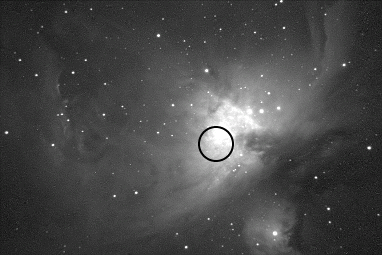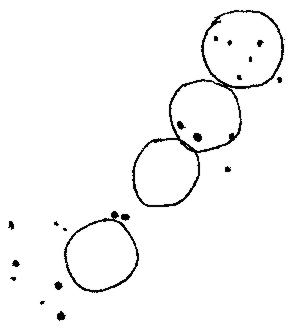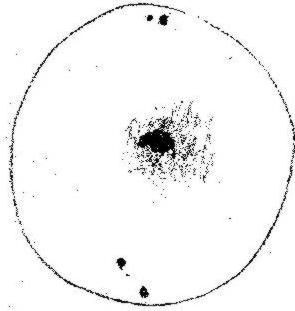Orion
Galileo originally intended to map the constellation of Orion, but he soon
decided that it was far too complex a task, due to the vast number of stars he
could see in the constellation through his telescope. He chose instead to
include in Siderius Nuncius a map of the portion of Orion around the sword, in
addition to a map of the Pleiades.

Galileo's map of a portion of Orion, showing about 80 stars in addition to the
ones which make up Orion's belt and sword. The tiny blue dot inside the red
circle represents the field of view (15 arc minutes) of Galileo's telescope.
The tiny field of
view shows the enormous amount of difficulty Galileo must have had in mapping
large regions of the sky.

A modern map of the entire constellation of Orion. The yellow dot within the
blue circle shows the field of view.
Looking at Galileo's map of a portion of Orion (above) it can be clearly seen
that he has not drawn the Orion nebula, the "fuzzy" star in the middle
of Orion's sword which measures a full degree in extent.

A photograph of the Orion nebula. The black circle shows the field of view.
Why did Galileo not include the nebula in his map? Many historians have
offered theories to explain this unusual oversight in a skilled
astronomical observer. Galileo may have failed to observe the nebula
altogether because it has changed in appearance since his lifetime, a theory
espoused by Thomas G. Harrison. He may, as suggested by Albert Van Helden,
have seen the Orion nebula but chosen not to publish
it in his map of Orion, assuming that, like the milky way, the nebula could
be resolved into a collection of individual stars given a telescope with
sufficient magnification. Tom Williams proposes that Galileo failed to
observe the Orion nebula because the field of view of his telescope (15
arc minutes) was so small that he would have been unable to detect the
subtle changes in brightness which make up the nebula. We hope to provide
some insight into these possibilities through observations of the Orion nebula
region using Galilean-type telescopes.
The following picture is a sketch of the sword region of the constellation
Orion. The dots represent stars, with the size of the dot being a rough
representation of the magnitude of the star. The circles overlayed on the
star map represent the field of view of the 10x Galilean telescope used to
make the observation. The group member who made the drawing was unable to see
the Orion nebula, which should appear on top of the two adjacent stars between
the two empty circles in the third field of view from the top.

Using a twenty-powered telescope with a large field of view (>60 arcminutes) in
the relative
darkness of Big Bend National Park, it was not difficult to see the Orion
nebula. (See sketch below.)

Although we have attempted to do so, no group member has as yet been able to
see the Orion nebula either within or outside of Houston using the ten-powered
Galilean telescope.
However, Tom Williams claims that, outside of Houston, he
was able to detect a slight increase in brightness in the field of view when he
oriented the telescope on the region where he knew the nebula to be.
The data so far
seem to support the theory that Galileo was simply unable to see the Orion
nebula due to the small field of view of his telescope. There are, however,
several variables that remain to be investigated before a conclusive judgement
can be made on this issue. Our failure to see the Orion nebula within and near
Houston could be due to any one of three possibilities: The magnification
(10x) may not have been sufficient, the field of view may have been too small to
permit detection of the light gradient, or light pollution from the city may
have obscured
the light gradient. Furthur research must be performed to determine which of
these variables is most likely. The effect of magnification can be tested by
using Galilean telescopes of varying magnifications. Unfortunately, the field
of view of a Galilean telescope decreases as its magnification increases, so
this will be a difficult problem to investigate. The effect of field of view
can be tested by itself by looking for the nebula using a set of non-Galilean
telescopes of the same magnification but differing fields of view (ranging
from, say, 5 to 100 arcminutes). In order to best emulate Galileo's viewing
conditions, the problem of light pollution should be eliminated to as great an
extent as possible. This could be done by visiting an isolated observatory.




